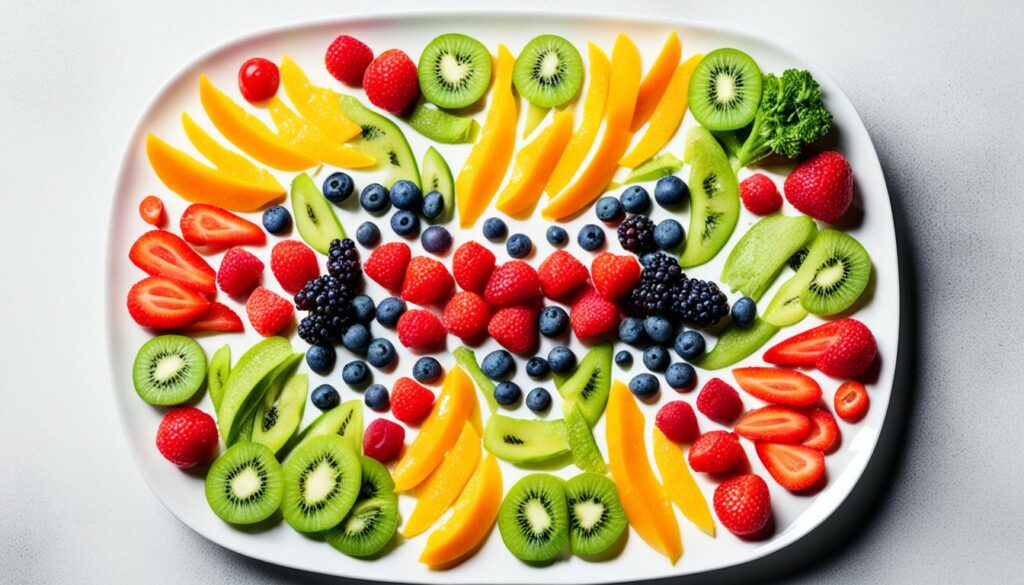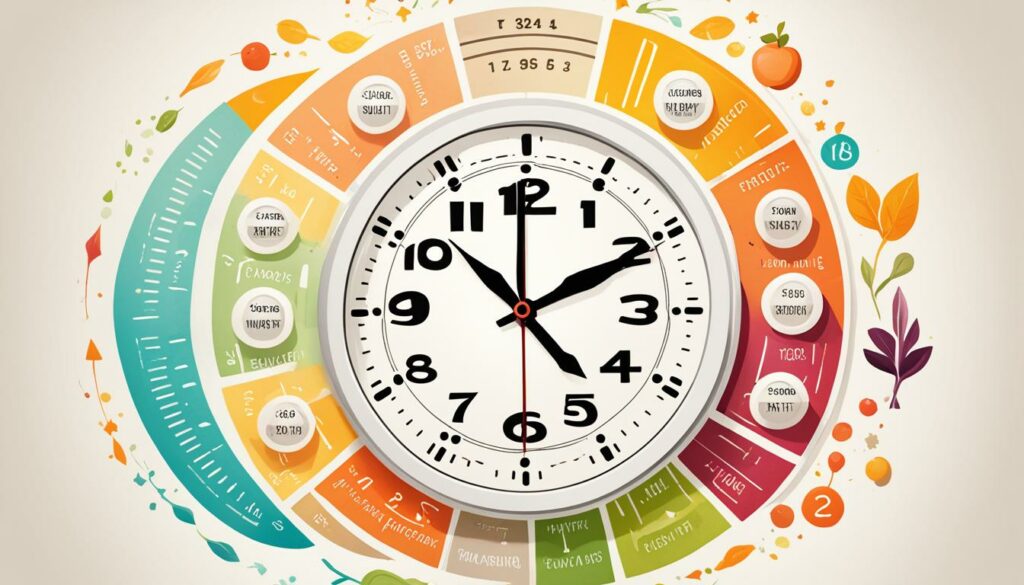In this comprehensive guide, we’ll explore a wide range of advanced weight loss techniques that can help you unlock your full potential and achieve your desired weight goals. We’ll delve into the science behind calorie deficits, optimize exercise routines for fat loss, boost your metabolism, fuel your body with a nutritious diet, and cultivate mindful eating habits. Whether you’re struggling with stubborn weight or looking to take your weight loss journey to the next level, this article will provide you with the tools and strategies you need to succeed. Get ready to transform your body and unlock a healthier, more confident you.
Key Takeaways
- Discover the power of calorie deficits for effective weight loss
- Optimize your exercise routines to burn fat and preserve muscle
- Learn techniques to boost your metabolism and increase calorie burn
- Fuel your body with a nutritious diet to support your weight loss goals
- Cultivate mindful eating habits for sustainable weight management
Mastering the Art of Calorie Deficit
Achieving sustainable weight loss begins with understanding the fundamental principles of calorie balance. At the core of any successful weight loss plan lies the concept of a calorie deficit, where you consume fewer calories than your body requires to maintain its current weight. By creating this deficit, you can trigger your body to dip into its fat reserves for energy, leading to gradual and healthy weight loss.
Understanding Your Basal Metabolic Rate
The first step in mastering the art of the calorie deficit is to determine your basal metabolic rate (BMR). Your BMR is the number of calories your body burns at rest, simply to perform vital functions like breathing, circulation, and digestion. Knowing your BMR is crucial, as it serves as the foundation for calculating your daily calorie needs.
Calculating Your Daily Calorie Needs
Once you’ve determined your BMR, the next step is to calculate your total daily calorie needs. This involves factoring in your activity level, as the more active you are, the more calories your body will require. By estimating your total daily energy expenditure, you can then establish a realistic calorie deficit that aligns with your weight loss goals without compromising your overall health and well-being.
Creating a Sustainable Calorie Deficit
With your daily calorie needs in mind, you can then work towards creating a sustainable calorie deficit. This means establishing a calorie reduction that is gradual and manageable, typically between 500 to 1,000 calories below your maintenance level. By avoiding drastic calorie cuts, you can ensure that your weight loss journey is sustainable, allowing you to lose weight at a steady pace while maintaining your energy levels and overall health.
Optimizing Exercise Routines for Fat Loss
When it comes to advanced weight loss techniques, exercise is a crucial component that can help you burn fat and transform your body. In this section, we’ll explore the benefits of two powerful exercise strategies: high-intensity interval training (HIIT) and strength training.
High-Intensity Interval Training (HIIT)
HIIT is a highly effective exercise routine that alternates short bursts of intense activity with periods of rest or lower-intensity exercise. This type of training has been shown to boost your metabolism, increase fat burning, and improve cardiovascular fitness. By incorporating HIIT into your exercise regimen, you can maximize your fat loss efforts and see quicker results.
Strength Training for Muscle Preservation
While cardio exercises like HIIT can help you burn calories and shed fat, it’s important to also incorporate strength training into your routine. Strength training helps to preserve and even build lean muscle mass, which is essential for maintaining a healthy metabolism. By engaging in regular strength training exercises, you’ll not only tone and sculpt your body but also rev up your calorie-burning potential, even at rest.
By optimizing your exercise routines with a combination of HIIT and strength training, you can unlock your full potential for fat loss and achieve the transformative results you’ve been seeking. Remember, consistency and patience are key, so stick with your exercise plan and trust the process.
Metabolism Boosting Strategies
Metabolism plays a vital role in weight loss, and in this section, we’ll share advanced techniques to help boost your metabolic rate. By implementing these strategies, you can unlock your body’s natural calorie-burning potential and make your weight loss journey more efficient.
Importance of Hydration
Staying hydrated is a crucial component of metabolism boosting. Drinking enough water can help increase your basal metabolic rate, as the body expends energy to warm the water to body temperature. Additionally, proper hydration can support healthy digestion and reduce feelings of fatigue, allowing you to stay active throughout the day.
Incorporating Spicy Foods
Adding spicy foods to your diet can provide a natural metabolism boost. Compounds found in chili peppers, such as capsaicin, have been shown to temporarily increase your body’s calorie-burning ability. Incorporating a variety of spicy ingredients, like cayenne, ginger, or mustard, into your meals can help rev up your metabolism and support your weight loss goals.
Staying Active Throughout the Day
While structured exercise is essential for weight loss, maintaining an active lifestyle throughout the day can also contribute to a boosted metabolism. Simple activities like taking the stairs, fidgeting, or even just standing more can help increase your overall calorie expenditure. By staying active and moving your body more, you can support your metabolism and make the most of your weight loss journey.
Fueling Your Body with a Nutritious Diet
A balanced, nutritious diet is the foundation for successful weight loss. In this section, we’ll explore the importance of incorporating protein-rich foods and fiber-filled foods into your meals to support your weight loss journey.
Protein-Rich Foods for Satiety
Consuming adequate amounts of protein-rich foods is crucial for maintaining muscle mass and promoting feelings of satiety. Foods such as lean meats, fish, eggs, legumes, and dairy products can help keep you feeling full for longer, reducing the likelihood of overeating and snacking throughout the day. By prioritizing protein-rich foods, you can curb your appetite and ensure your body has the necessary building blocks to preserve and build lean muscle, which in turn boosts your metabolism.
Fiber-Filled Foods for Digestion
Incorporating fiber-filled foods into your nutritious diet can also support your weight loss goals by promoting healthy digestion and gut function. Fruits, vegetables, whole grains, and nuts and seeds are excellent sources of dietary fiber. These foods can help regulate bowel movements, improve feelings of satiety, and provide a steady supply of essential vitamins and minerals. By nourishing your body with fiber-filled foods, you’ll not only lose weight but also improve your overall health and well-being.

Mindful Eating: The Key to Sustainable Weight Loss
Beyond the physical aspects of weight loss, we’ll explore the power of mindful eating. Cultivating a mindful approach to your relationship with food can lead to more sustainable weight loss results. In this section, we’ll discuss strategies for tuning into your body’s hunger and fullness cues, practicing portion control, and developing a healthier mindset around food.
By incorporating mindful eating habits, you’ll be able to enjoy your meals while making informed choices that support your long-term weight management goals. This holistic approach to weight loss can help you achieve a balanced, healthy lifestyle that is both effective and satisfying.
At capturediet.com, we believe that mindful eating is the key to unlocking sustainable weight loss. When you’re in tune with your body’s signals and approach food with intention, you’re more likely to make choices that nourish both your physical and emotional well-being. By practicing portion control and cultivating a positive relationship with food, you’ll be empowered to make lasting changes that support your overall health and fitness goals.
Intermittent Fasting: A Powerful Tool for Fat Loss
Intermittent fasting has emerged as a game-changing strategy in the world of advanced weight loss techniques. This approach to eating cycles between periods of fasting and eating, harnessing the body’s natural metabolic processes to promote fat loss, improve insulin sensitivity, and reduce inflammation.
Different Intermittent Fasting Protocols
From the popular 16/8 method, where individuals fast for 16 hours and have an 8-hour eating window, to the more structured 5:2 diet, which involves consuming a reduced-calorie intake for two non-consecutive days per week, there are various intermittent fasting protocols to explore. Each approach has its own unique benefits and considerations, allowing individuals to find the right fit for their lifestyle and weight loss goals.
Benefits and Potential Drawbacks
The potential benefits of intermittent fasting are numerous. Increased fat burning, improved insulin sensitivity, and reduced inflammation are just a few of the metabolic advantages that this approach can offer. However, it’s essential to consider potential drawbacks, such as feelings of hunger or low energy during the fasting periods, and ensure that the protocol aligns with your overall health and well-being.
Ultimately, intermittent fasting can be a powerful tool in your weight loss arsenal, but it’s important to approach it with a well-informed and balanced perspective. By exploring the various fasting protocols and weighing the benefits and drawbacks, you can determine if intermittent fasting is the right fit for your fat loss journey.

Combining Diet and Exercise Strategies
To achieve optimal weight loss results, it’s crucial to combine a well-designed diet plan with an effective exercise routine. By integrating these two key components, you’ll be able to create a balanced and sustainable approach that supports your long-term goals. In this section, we’ll explore the importance of blending diet and exercise strategies for maximum impact.
Tracking Progress and Adjusting Accordingly
Regularly tracking your progress is essential for ensuring the continued success of your weight loss journey. Whether you choose to monitor your body measurements, body composition analysis, or simply observe your energy levels and overall well-being, staying attuned to these metrics will help you identify areas for adjustment. By making informed adjustments to your diet and exercise plan as needed, you can maintain the momentum and keep your weight loss efforts on track.
At capturediet.com, we believe that the key to sustainable weight loss lies in the ability to adapt and evolve your strategies as you progress. By closely tracking your progress and making necessary adjustments to your plan, you’ll be able to fine-tune your approach and achieve the long-lasting results you desire.
Portion Control: The Underrated Weight Loss Hack
One often overlooked aspect of advanced weight loss techniques is the importance of portion control. By mastering the art of portion control, we can enjoy our favorite foods while staying on track with our weight loss goals. In this section, we’ll explore simple yet effective strategies to help us achieve this.
Using Smaller Plates and Bowls
A simple but powerful trick to control our portions is to use smaller plates and bowls. This visual cue can trick our brain into feeling satisfied with less food, as the smaller serving sizes appear more substantial on a smaller dish. By incorporating this habit into our daily routine, we can gradually adjust our perception of what constitutes a “normal” portion, making it easier to maintain a calorie deficit without feeling deprived.
Meal Prepping and Portioning
Another effective strategy for portion control is meal prepping and portioning. By taking the time to prepare our meals in advance and portion them out into individual servings, we can ensure that we’re consuming the right amounts of nutrients while staying within our desired calorie range. This approach not only helps us maintain a sustainable calorie deficit but also simplifies our meal planning and reduces the temptation to overeat.
By implementing these portion control strategies, we can unlock the power of this underrated weight loss hack and enjoy our favorite foods while making steady progress toward our weight loss goals. Remember, capturediet.com is here to support you every step of the way as you embark on this transformative journey.

